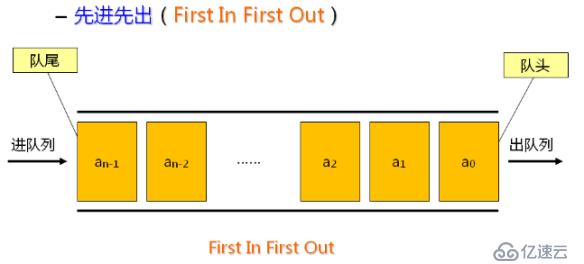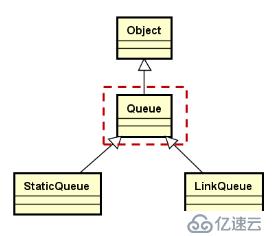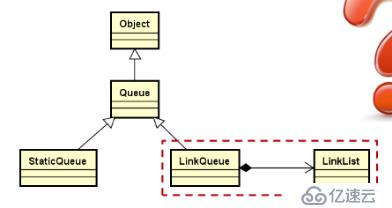溫馨提示×
您好,登錄后才能下訂單哦!
點擊 登錄注冊 即表示同意《億速云用戶服務條款》
您好,登錄后才能下訂單哦!
隊列是一種特殊的線性表,僅能在線性表的兩端進行操作。


template < typename T >
class Queue
{
public:
virtual void enqueue(const T& e) = 0;
virtual void dequeue() = 0;
virtual T front() const = 0;
virtual void clear() = 0;
virtual int length() const = 0;
};順序隊列的實現:
設計要點:
類模板,使用原生數組作為隊列 存儲空間,使用模板參數決定隊列的最大容量;
template < typename T, int N >
class StaticQueue : public Queue<T>
{
protected:
T m_space[N];
int m_front;
int m_rear;
int m_length;
public:
StaticQueue()
void enqueue(const T& e)
void dequeue()
T front() const
void clear()
int length() const
int capacity() const
};注意事項:
StaticQueue實現要點:(循環計數法) 提高隊列操作的效率(本質上時循環隊列)
關鍵操作:
隊滿:(m_length == N) && (m_front == m_rear)
StaticQueue最終實現:
template < typename T, int N >
class StaticQueue : public Queue<T>
{
protected:
T m_space[N];
int m_front;
int m_rear;
int m_length;
public:
StaticQueue() //O(1)
{
m_front = 0;
m_rear = 0;
m_length = 0;
}
void enqueue(const T& e) //O(1)
{
if(m_length < N)
{
m_space[m_rear] = e;
m_rear = (m_rear + 1) % N;
m_length++;
}
else
{
THROW_EXCEPTION(InvalidOperationException, "no space in current staticqueue...");
}
}
void dequeue() //O(1)
{
if(m_length > 0)
{
m_front = (m_front + 1) % N;
m_length--;
}
else
{
THROW_EXCEPTION(InvalidOperationException, "no element in current staticqueue...");
}
}
T front() const //O(1)
{
if(m_length > 0)
{
return m_space[m_front];
}
else
{
THROW_EXCEPTION(InvalidOperationException, "no element in current staticqueue...");
}
}
void clear() //O(1)
{
m_front = 0;
m_rear = 0;
m_length = 0;
}
int length() const //O(1)
{
return m_length;
}
int capacity() const //O(1)
{
return N;
}
bool is_empty() //O(1)
{
return (m_length == 0) && (m_front == m_rear);
}
bool is_full() //O(1)
{
return (m_length == N) && (m_front == m_rear);
}
};順序隊列的缺陷:當數據為類類型時,StaticQueue的對象在創建時,會多次調用元素類型的構造函數,影響效率。所以我們采用鏈式存儲結構來實現隊列。
設計要點:
1.類模板,繼承自抽象父類Queue;
2.在內部使用鏈式結構實現元素的存儲
3.只在鏈表的頭部和尾部進行操作。
LinkQueue聲明:
template <typename T>
class LinkQueue : public Queue<T>
{
protected:
LinkList<T> m_list;
public:
LinkQueue(){}
void enqueue(const T& e) //O(n)
void dequeue() //O(1)
T front() const //O(1)
void clear() //O(n)
int length() const //O(1)
};LinkQueue最終實現:
template <typename T>
class LinkQueue : public Queue<T>
{
protected:
LinkList<T> m_list;
public:
LinkQueue(){}
void enqueue(const T& e) //O(n)
{
m_list.insert(e);
}
void dequeue() //O(1)
{
if(m_list.length() > 0)
{
m_list.remove(0);
}
else
{
THROW_EXCEPTION(InvalidOperationException, "no elemet in current LinkQueue...");
}
}
T front() const //O(1)
{
if(m_list.length() > 0)
{
return m_list.get(0);
}
else
{
THROW_EXCEPTION(InvalidOperationException, "no elemet in current LinkQueue...");
}
}
void clear() //O(n)
{
while (m_list.length() > 0)
{
m_list.remove(0);
}
}
int length() const //O(1)
{
return m_list.length();
}
};LinkQueue中,入隊操作由于只能操作隊列的尾部(鏈表的最后位置),要進行遍歷操作,所以時間復雜度為O(n),可以使用雙向循環鏈表代替單鏈表來解決這個問題。
免責聲明:本站發布的內容(圖片、視頻和文字)以原創、轉載和分享為主,文章觀點不代表本網站立場,如果涉及侵權請聯系站長郵箱:is@yisu.com進行舉報,并提供相關證據,一經查實,將立刻刪除涉嫌侵權內容。